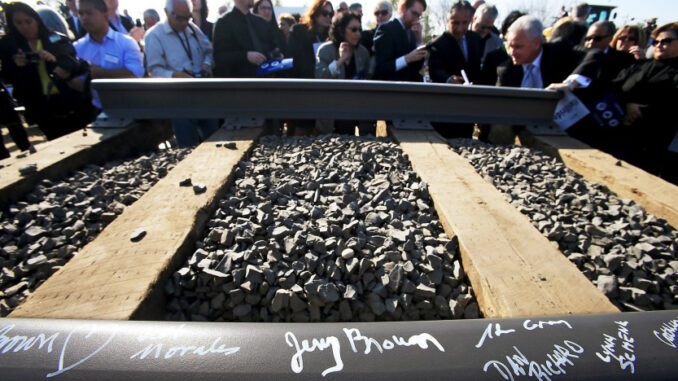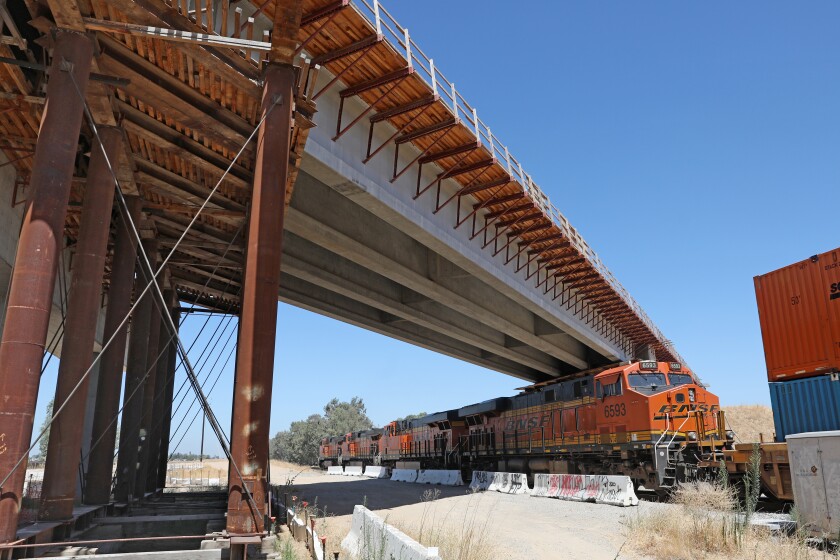
It was just last year that Gov. Gavin Newsom said he would need to downsize California’s ambitious bullet train project, because the state could afford only a limited system from Merced to Bakersfield.
But even the viability of that scaled-down $20.4-billion plan is becoming uncertain as construction costs rise in the San Joaquin Valley, expected revenues are under pressure and land acquisition problems continue to mount.
The changing conditions have prompted the California High-Speed Rail Authority to launch a comprehensive reassessment of its plans, said Chief Executive Brian Kelly, who is facing tougher questions by state leaders, given the austere outlook.
“I just want the truth,” said Assembly Transportation Chairman Jim Frazier (D-Discovery Bay), a former general contractor who has grown distrustful of the project’s planning. “I want an independent analysis of what can be accomplished and how much it is going to cost.
Contractors for the rail authority are filing massive change orders and delay claims, according to disclosures by the agency and internal documents obtained by The Times. Additional land is also needed, adding to costs.
At the same time, the bullet train’s funding has taken several big hits. California’s cap-and-trade greenhouse gas auction system has provided about $3 billion to the rail project since 2015 and is counted on to provide at least $500 million annually until 2030.
But as a result of COVID-19’s economic impacts, the last two auctions shorted the project by $140 million from what the authority had budgeted.
The Trump administration last year terminated a $929-million grant, which is in legal dispute. But the money is still counted in the project budget.
Cumulatively, the increased costs and decreased revenues are saddling Newsom’s plan with a potential fiscal hole of more than $1 billion. At the same time, some valley property owners are growing increasingly frustrated, having waited for years to be compensated for their land and endured disruptions caused by construction.
The project will face a tough hurdle if weak revenues and rising costs drive a request for more money to just complete the San Joaquin Valley construction, Frazier said.
Frazier still supports the concept of high-speed rail but is blunt that the public “is getting less and it is costing more” and “there is a point of no return, obviously.”
The impacts of COVID-19 are forcing the rail authority’s reassessment, Kelly said. The money to execute the entire Los Angeles-to-San Francisco project was never in hand, and the state has incrementally managed the project, step by step, the agency’s CEO said.
The new assessment, he said, is examining four issues: revenues, costs, project scope and the schedule, resulting in a pause in finalizing the 2020 business plan. Any changes would be submitted to the rail authority board and then the governor, Kelly said.
“Challenges come,” he added. “It is part of life, the global pandemic.”
The Times asked the governor for an interview on the problems facing his project. In response, Transportation Secretary David S. Kim said in a statement, “Gov. Newsom remains committed to building high-speed rail in California, starting with electrified track in the Central Valley.”
The governor’s plan was always at risk because of thin financial margins. Under his blueprint, the state could count on $20.6 billion coming in by 2030 to pay for the 171-mile system. Trains are supposed to start running by 2028.
The revenue picture could brighten if and when the COVID-19 pandemic ends and an improving economy drives the need for more greenhouse gas permits. The rail authority was once optimistic that an extra $2.8 billion would flow out of the auctions, but only three of 21 auctions since 2015 were high enough to support those projections.
“There is a lot of uncertainty,” said Ross Brown, a greenhouse gas expert at the Legislative Analyst’s Office. Brown expects improved results in a November auction, but future-year revenues depend on a variety of factors, such as emissions technology and economic growth.
Bullet train supporters are also pinning their hopes on a Joe Biden presidential victory, combined with Democratic control of Congress. Biden, a longtime proponent of passenger trains, has called for a “rail revolution” and might support additional federal funding for the California project. But if elected, he’d face pressure from multiple interests on how to spend any stimulus money.

The bigger risk facing Newsom’s blueprint falls on the cost side of the equation, which appears to be deteriorating.
The rail authority agreed in November 2019 to pay $134 million for causing delays to a construction team led by Spanish firm Dragados. The claim was disclosed in rail authority documents but has not been previously reported.
In June, Tutor Perini, the firm leading construction in the Fresno County area, was paid more than $400 million for delays and construction changes.
Kelly, the chief executive, said those payments will be covered by contingency funds built into the project’s budget, but much of the contingency created only last year has been used up.
In addition, Tutor has a pending demand for an additional $500 million, according to non-public correspondence from construction manager Garth Fernandez to Tutor Perini on July 1, which was obtained by The Times. Such demands are often settled for less, Kelly said.
Tutor’s original contract was for $1.02 billion, but has increased to a current value of $2.2 billion, not including the pending claim, according to the correspondence.
The claims for both Dragados and Tutor Perini relate largely to acquiring land. The project was supposed to be “shovel ready” in 2009 when the Obama administration issued a $2.2-billion federal grant from the Great Recession stimulus program, but in fact the state did not own a single square foot of property.
The rail authority estimated in June that it would need 2,353 parcels in the Central Valley, but had acquired only 1,664 — leaving 689 parcels still to be acquired.
By comparison, in June 2019, the rail authority thought it needed 1,843 parcels and had acquired 1,516 — short by 327. So, the authority needs to buy far more parcels today than it did a year ago when it was already far behind schedule.
In the last 12 months, the authority acquired only 148 parcels. Unless it accelerates its performance, it could take four years to get all of the property and only then could the rail authority commence construction — blowing federal deadlines. Kelly said the most recent quarter showed strong improvement and noted that the rail authority is being fully transparent by disclosing such details.
An internal planning document obtained by The Times shows that just in the Fresno area the project is contending with 52 “critical” problems that could delay the schedule.
“Every one of those drives the duration of the job,” said a key engineer who is not authorized to speak to the news media. “It isn’t getting any better.”
The effect of the problems is not just on the rail project, but on Central Valley land owners who face repeated demands for more of their land, delayed payments and uncertain futures. Newsletter
Get our Boiling Point newsletter for the latest on the power sector, water wars and more — and what they mean for California. Enter Email Address
You may occasionally receive promotional content from the Los Angeles Times.
One contentious land take involved the Fresno Rescue Mission, the largest homeless shelter in the hard-hit Central Valley, which just recently resolved a 3-year-old legal dispute with the rail authority.
The church-based mission lost half of its 12 acres in downtown, far from the original commitment that it have the same acreage, Chief Executive Matt Dildine said. The settlement will still allow future growth, though some of the property it received in trade is under a freeway bridge, he said.
“I feel that they reneged on their promises,” Dildine said. “It is their interest to lowball you and bleed you. The rules are set up against people like us. I felt it was unfair.”
In July, Kelly met online for three hours with Dildane, several farmers, a banker and others in the Central Valley who complain about slow payments.
“I apologized to all of them for the experience they had with the authority,” Kelly said. But he said the authority has to follow state law, adding, “Nobody is getting stiffed.”
John Diepersloot, a fruit grower, complained on the call that he is out $2 million in direct costs for replacing lost irrigation systems, roads and agricultural production, causing a cash crunch four years after the state took a big chunk of his orchard. He worries his bankers will call his loans.
“Does Gov. Newsom know how this project is unfolding in the fields?” asked Mark Wasser, Diepersloot’s attorney.



Be the first to comment